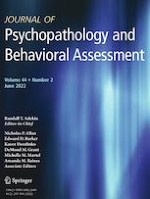07-03-2022
Self-Imagery and Attentional Control Maintenance Factors of Social Anxiety: A Comparison of Trait and State Assessments
Gepubliceerd in: Journal of Psychopathology and Behavioral Assessment | Uitgave 2/2022
Log in om toegang te krijgenAbstract
Models of social anxiety (SA) posit that socially-evaluative fears may be maintained by biased cognitive processes such as attention and self-imagery. However, extant literature has yielded inconsistent data regarding the differential roles that self-imagery plays in SA, as well as high and low attentional control (AC) abilities. These inconsistencies may be in part a result of differences in trait and state methodologies used to assess self-imagery. The present study provides a comparison of trait and state assessments of self-imagery between groups of individuals with high and low SA and AC. After completing self-report measures of social anxiety, attentional control, and trait self-imagery, 96 participants engaged in negative, positive, and neutral audio manipulations to evoke state self-imagery. Subsequently, participants responded to items regarding the extent to which and how they engaged with these self-imagery scenarios. Trait self-imagery results indicated that those with lower AC reported more anxiety-provoking and negative self-imagery, whereas those with higher SA engaged in more aversive, anxiety-provoking, and negative self-imagery. Those with greater AC accompanied with high SA reported more aversive self-images. Conversely, state self-imagery results indicated that valence of self-images affects different characteristics of self-images themselves (i.e., negatively-valenced self-images are more aversive, anxiety-provoking, negative, less accessible, and elicit greater urges to avoid in engagement) rather than serving as a distinguishing factor for SA or AC. Given these differential effects, trait assessment may reveal important characteristics of self-imagery that perpetuate SA, and state assessment may not measure the same mechanisms.
